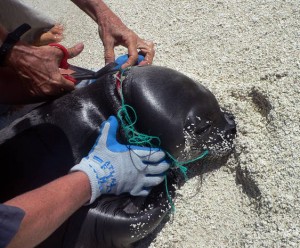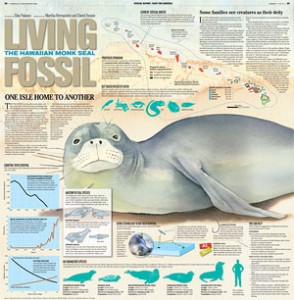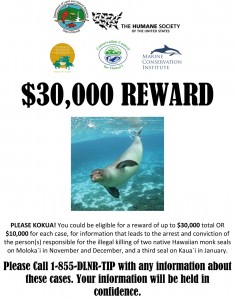Media Watch, The Republic, 26 January 2012

Federal data show cutting Hawaiian monk seals free from fishing nets, moving vulnerable pups away from preying sharks and other efforts to rescue the animals are significantly helping the endangered species.
One-fifth of the roughly 1,100 Hawaiian monk seals in the world are alive today because of interventions to save them, their mother or their grandmother between 1994 and 2009, figures from the National Oceanic and Atmospheric Administration show.
The seal population is also about 30 percent larger today than it would have been if authorities didn’t act. [More]
Source: Feds: Hawaiian monk seal population is 30 percent higher today because of rescue efforts, The Republic, Audrey McAvoy/AP, 26 January 2012.


 Rewards of up to $30,000, the largest of its kind in Hawaii, are being offered for confidential tips that lead to the arrest and conviction of whoever killed three critically endangered Hawaiian monk seals on Molokai and Kauai since November.
Rewards of up to $30,000, the largest of its kind in Hawaii, are being offered for confidential tips that lead to the arrest and conviction of whoever killed three critically endangered Hawaiian monk seals on Molokai and Kauai since November. The Aquatic Mammals special edition on Mediterranean and Hawaiian monk seals, whose publication was announced with some excitement in September last year, has finally been made available for public purchase. As far as we can ascertain, those unlucky enough not to have institutional access or public libraries with AA subscriptions, will be paying $12 for each paper they choose to purchase. One author, Giulia Mo (listed below) has, however, asked us to inform interested readers that she will email copies of her paper free of charge to those who request it. Please contact:
The Aquatic Mammals special edition on Mediterranean and Hawaiian monk seals, whose publication was announced with some excitement in September last year, has finally been made available for public purchase. As far as we can ascertain, those unlucky enough not to have institutional access or public libraries with AA subscriptions, will be paying $12 for each paper they choose to purchase. One author, Giulia Mo (listed below) has, however, asked us to inform interested readers that she will email copies of her paper free of charge to those who request it. Please contact: